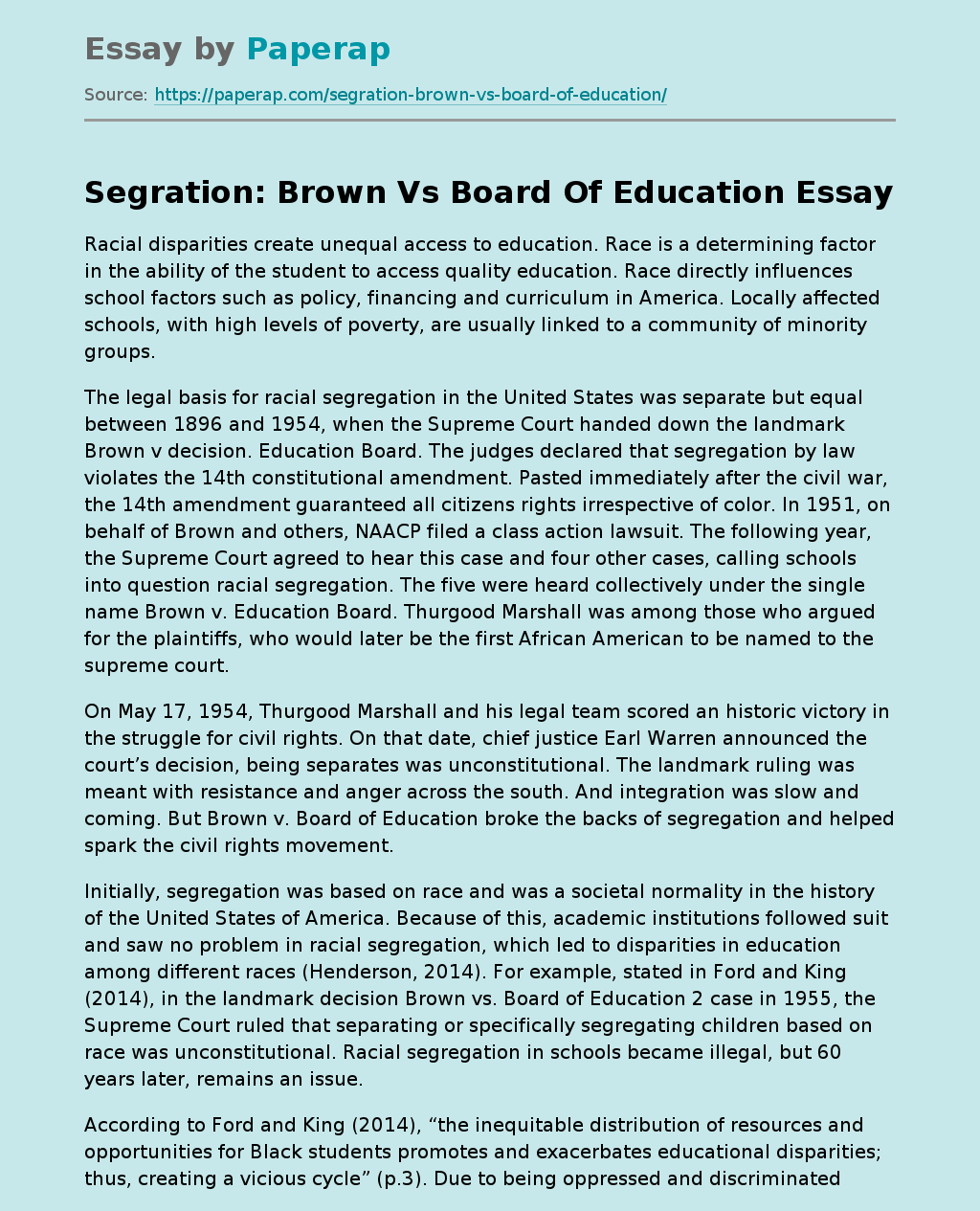Segration: Brown Vs Board Of Education
Racial disparities create unequal access to education. Race is a determining factor in the ability of the student to access quality education. Race directly influences school factors such as policy, financing and curriculum in America. Locally affected schools, with high levels of poverty, are usually linked to a community of minority groups.
The legal basis for racial segregation in the United States was separate but equal between 1896 and 1954, when the Supreme Court handed down the landmark Brown v decision. Education Board.
The judges declared that segregation by law violates the 14th constitutional amendment. Pasted immediately after the civil war, the 14th amendment guaranteed all citizens rights irrespective of color. In 1951, on behalf of Brown and others, NAACP filed a class action lawsuit. The following year, the Supreme Court agreed to hear this case and four other cases, calling schools into question racial segregation. The five were heard collectively under the single name Brown v. Education Board. Thurgood Marshall was among those who argued for the plaintiffs, who would later be the first African American to be named to the supreme court.
On May 17, 1954, Thurgood Marshall and his legal team scored an historic victory in the struggle for civil rights. On that date, chief justice Earl Warren announced the court’s decision, being separates was unconstitutional. The landmark ruling was meant with resistance and anger across the south. And integration was slow and coming. But Brown v. Board of Education broke the backs of segregation and helped spark the civil rights movement.
Initially, segregation was based on race and was a societal normality in the history of the United States of America. Because of this, academic institutions followed suit and saw no problem in racial segregation, which led to disparities in education among different races (Henderson, 2014). For example, stated in Ford and King (2014), in the landmark decision Brown vs. Board of Education 2 case in 1955, the Supreme Court ruled that separating or specifically segregating children based on race was unconstitutional. Racial segregation in schools became illegal, but 60 years later, remains an issue.
According to Ford and King (2014), “the inequitable distribution of resources and opportunities for Black students promotes and exacerbates educational disparities; thus, creating a vicious cycle” (p.3). Due to being oppressed and discriminated, too many African American males and females fail to reach their potential in our schools and gain access to school programs.
Furthermore, minority youth are further disengaged from the school by the lack of cultural representation in textbooks. Their culture and experience are devalued (Henderson). Eventually, situations would come to challenge the social confines of segregation and how it affected everyday life. Racism is a barrier that continues to play an active role in everyday life worldwide. Ralph Ellison (1952), as cited in Henderson, (2014) states, “I am invisible; understand, simply because people refuse to see me.” Racial tensions may be less in America, but inequality still exist, and the effects still harm low-income and minority students.
School workers are normally employed by the school district or an agency contracted to provide services to the school district. The role of a school social worker is helpful in providing teachers with resources to understand their students’ cultural backgrounds so that they avoid culture clash. Training on cultural competency could be taught to teachers. Students can also be educated and counseled by their school social worker to explore their own culture. Finigan-Carr and Shaia indicated, “they also are dedicated to providing comprehensive supports that address many of the out-of-school needs that limit students’ learning” (p.26). There are many services that a school social worker can do, as educators, to better serve, support, and educate economically disadvantaged students.
As mentioned in Finigan-Carr (2018), school social workers “assume leadership in providing effective quality programming that can ensure that the needs of children and families are met” (Carr, p. 29). Take the time to know the students one on one. Discover the way they think. Let the children speak first so that they won’t be nervous. Be there for educational and emotional support, listen to the needs and get to know the whole child. A social worker is there to value the student and treat them with respect. Convince them that they are important. Show them that they bring important skills to the classroom and the world. A social worker can help them understand equality and make them feel equal.
Explaining to the children and family by letting them know that they are not alone and that you are there to advocate for them and help provide family services is crucial. A school social worker is involved in the committee and does research on what’s going on around them to better provide for young clients in the school system. According to Carr (2018), “social workers work with parents in these situations to access school and community resources that may help families reduce these stressors and improve the family’s outcomes” (p. 27). School social workers can link parents to unemployment resources to help gain new training or help in getting a job to become financially stable. Resources are everywhere and there could be activities that can be provided to children who cannot afford services from school. Another approach used is to engage school’s partners and local businesses when finances are necessary. A difference can be made for schools with lots of dedication and time and a willingness to help the less fortunate. As a social worker in the school system, the vision should be to nurture young children ‘s curious minds, to create lasting trust and to inspire joy in learning.
Segration: Brown Vs Board Of Education. (2021, Dec 10). Retrieved from https://paperap.com/segration-brown-vs-board-of-education/

